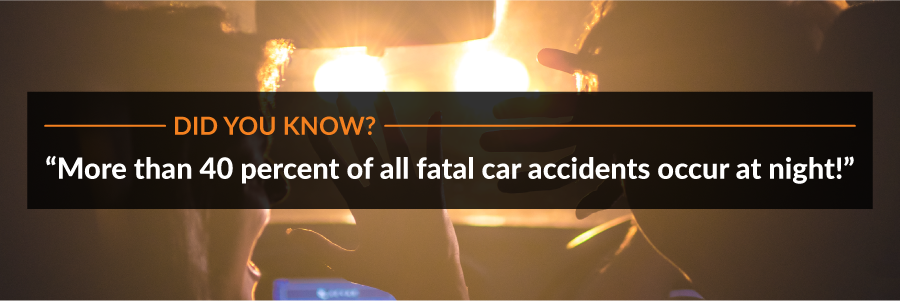Good night vision may save your life and others’. If you drive around at night, please take some time to read this.
What is night vision?
Night vision is the ability to see in low-light conditions such as during nighttime. Humans have poor night vision compared to many animals partly because the human eye lacks a tapetum lucidum, a layer of tissue lying immediately behind the retina (back of the eye) which reflects visible light back to the retina, increasing the light available to the photoreceptors. This tissue, which humans don’t have, contributes to the superior night vision of some animals.
An estimated 90 percent of all driver decisions are made based on what they see.
Sunlight provides the strongest light source for drivers to see. When the sun goes down at night, our eyes will adjust to lower levels of light (pupils dilate in darkness and constrict in brightness). However, our eyes have difficulty functioning properly when switching from bright to dark and vice versa. This is one of the challenges we face with nighttime driving. Whilst our eyes are capable of seeing in limited light, the combination of road lights, headlights and the darkness beyond them can cause disparity between light and dark, causing several problems for our vision. Therefore, car drivers must take extra precaution to avoid an accident whilst driving at night.
 Did you know? Despite an estimated 60 percent less traffic on the roads during the night, more than 40 percent of all fatal car accidents occur at night! Here are some reasons why:
Did you know? Despite an estimated 60 percent less traffic on the roads during the night, more than 40 percent of all fatal car accidents occur at night! Here are some reasons why:
- Drivers are not able to see as well in low-light conditions.
- Drunk drivers are more likely to be on the road at night.
- Driving whilst sleepy (drowsy driving) also occurs during the night when people are winding down and growing sleepy.
Some tips for a safer nighttime driving:
- Allow for enough distance to stop. We recommend that you gauge this distance using your headlights. Low beams should allow you to see up to 50 metres away, whilst high beams should illuminate about 150 metres in front of you. Ensure that if and when you must brake hard, you can brake within those distances.
- Keep your dashboard lights at a safe low setting. The contrast between bright and dark impedes vision. Limiting the brightness in your car should help you see at night and avoid car accidents.
- Always keep your windshield and windows clean. It is very important to limit the glare from other headlights. A dirty windshield won’t help in this regard.
- Limit distractions. Your vision will not be as good as it is during the day, so your reaction times will also be slower than normal. This is why when driving at night, you should focus your attention on the road even more than you would during other times.
- Invest in special driving spectacles. Most optometrists provide special lenses for different purposes, and one of them is for an enhanced driving experience both for daytime and nighttime driving. Don’t be shy to ask your local optical dispenser what they can offer to provide you the visual support you need so that driving at night can be a more pleasant and safer experience for you.
Keep in mind that there are several potential dangers you may face whilst driving at night. Ensure that your night vision is able to help keep you and others safe, so you can drive on with peace of mind.

